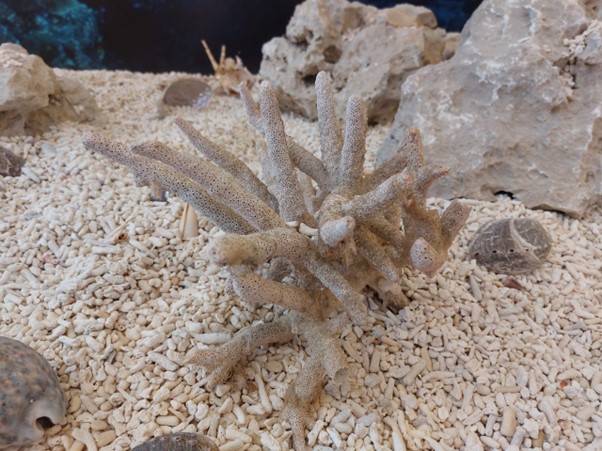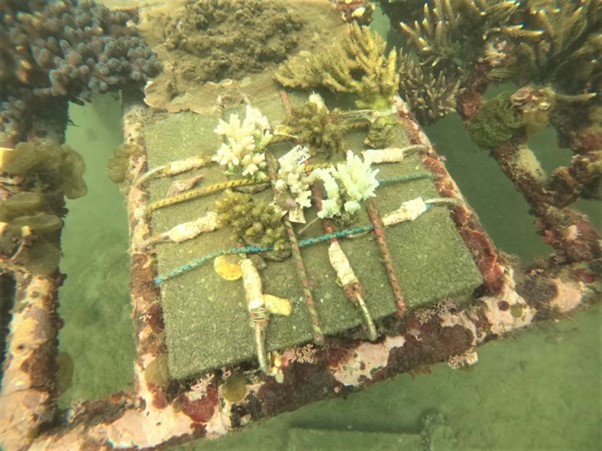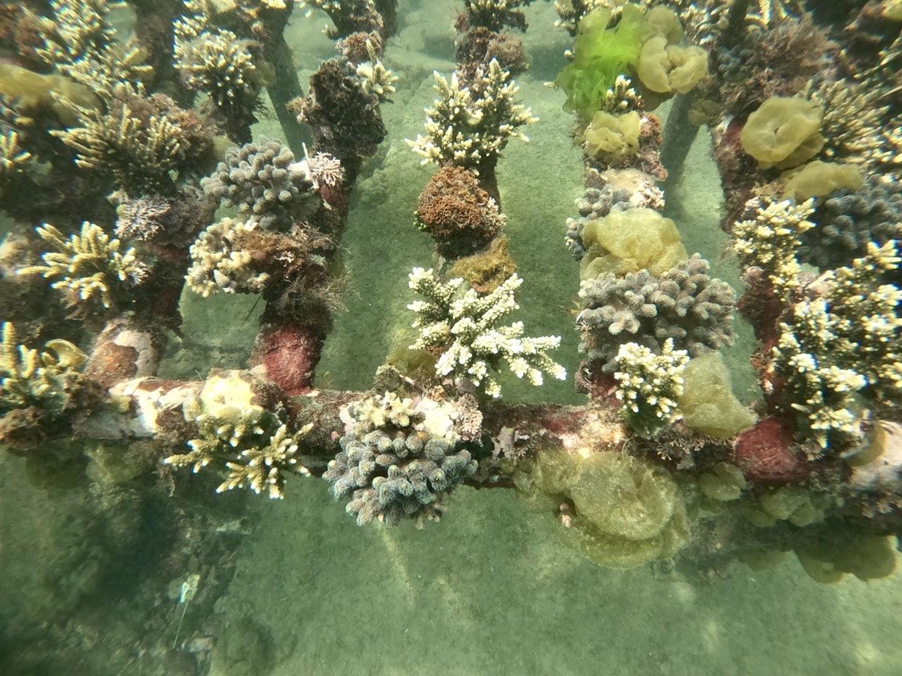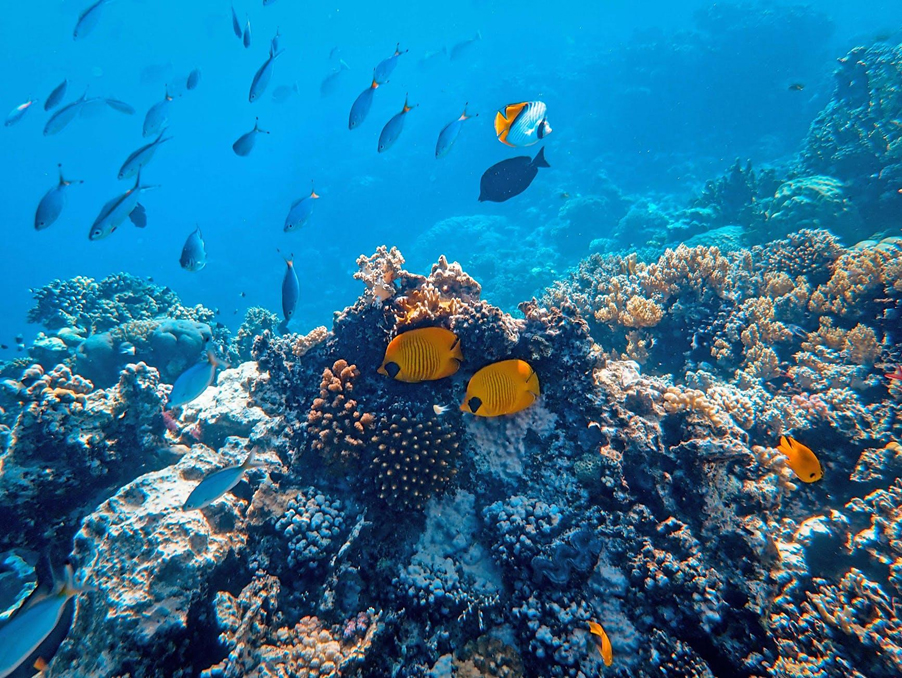Reporters/ Caleb Jax Stone , HUANG, SHIH-YUAN, LI, PEI-SYUAN, HSU,CHIH-JUNG

The world’s magnificent oceans are filled with many creatures; one of the most important being coral, which harbors stunning ecosystems admired by divers and ocean-lovers alike. Healthy coral reefs contribute to the well-being of their ecosystems and the world. In fact, coral reefs are known to produce about 50% of the world’s oxygen supply, keeping various species that live within the ocean and upon land alive.
But despite this, the world’s coral is dying off due to factors such as rising temperatures, human activities, and industrial development.
Contrary to common belief, coral is not a plant, but rather, a collection of tiny animals called “polyps.” These polyps have a symbiotic relationship with a microscopic type of algae called zooxanthellae, which provide food for and give corals their color. When a coral becomes stressed, the zooxanthellae will leave the coral, causing the tissues to turn pale. If conditions improve, a coral can recover from bleaching.
However, if the coral lacks zooxanthellae for an extended period of time, it cannot eat and will eventually die off, leaving its white skeleton and decaying flesh behind. Thus, coral bleaching is a coral’s distressed cry for help.
Tongyun Fan, a project researcher at National Museum of Marine Biology, stated, “Coral bleaching is a global phenomenon, and is found in places such as the Great Barrier Reef in Australia, Florida, and Hawaii.” This worldwide issue has been on the rise, and many scientists have claimed that half of the world’s shallow-water coral reefs have already experienced bleaching.
Two of the broadest classifications of coral are hermatypic (reef-building corals) and ahermatypic (non-reef-building corals). They are categorized according to their ecological functions. Bleaching primarily occurs in hermatypic corals. When parts of, or an entire coral reef experience bleaching, not only will the corals be affected but also all of the other creatures which live within the ecosystem.
Fan added to this fact by commenting, “After coral bleaches or fully dies, it will lose the ability to build coral reef habitats and even lose its function of nurturing and maintaining biodiversity.”
All creatures in the ocean rely on each other in some way or another. Many species of fish use coral for shelter and food, and these smaller fish provide food for larger fish, and larger fish provide food for eels, sharks, humans, and so on; thus, the food chain becomes unbalanced. If one part of the ecosystem is affected, it will cause a catalyst and all parts will eventually suffer.
Action Around the Globe
Boasting approximately one-third of the world’s coral species, Taiwan is no stranger to the issue of coral bleaching. Yi-Ling Chiu, a postdoctoral researcher from the Atmosphere and Ocean Research Institute of University of Tokyo, revealed, “The most serious coral bleaching event in Taiwan was in 2020.
Due to rising sea temperatures, large-scale coral bleaching events occurred in the waters around Taiwan, mainly in Xiao Liuqiu, Green Island, Kenting, Penghu, and the Northeast Corner. Corals in some of these areas have slowly recovered from bleaching, but many have also died.” Specifically, Fan mentioned that in Houbi Lake, the corals affected have not recovered since the bleaching in 2020.

Many countries around the world are now taking notice of the severity of coral bleaching and are enforcing and enacting laws to protect them. Chiu stated that Japan began paying attention to marine ecosystems and started taking action roughly ten years earlier than Taiwan. However, the first steps were not led by the government, but rather, the local fishermen.
“The local fishermen began to notice changes and asked questions, like, ‘why did catches decrease?’ So they thought about the reason themselves, and finally realized that it was caused by the destruction of marine ecology,” Chiu said. The local fishermen then went to researchers to get help with studying the situation and confirmed that coral bleaching was indeed the reason.
Later, they took the initiative to raise corals and protect the marine ecological environment themselves. Chiu stated, “To do this, the government gave the fishermen grants.”

According to Chiu, many companies in Japan donate a portion of their profits to protect marine ecosystems. She said that Taiwan is slowly starting to follow this trend as well. But the dilemma comes with the production of plastics and chemicals which are known to negatively affect the environment.
“When focusing on economic growth, it is inevitable that some of our environment will be harmed,” she stated. In order for humans to coexist with the natural world, it is important to find a balance with new solutions that can allow the economy to flourish while placing importance on keeping the environment clean and healthy.
Chiu mentioned, “In fact, Taiwan already has many laws and regulations (to protect marine environments). For example, Taiwan has (and is continuing to) set up national parks, such as the sea area of Kenting. It is not easy to enter; you must have some legal documents to be able to enter.” However, unlike places such as Palau and Hawaii, Taiwan has yet to place any bans on sunscreen.
Chiu suggested, “I think brands that contain particularly bad chemicals must be banned, because those substances are known to be harmful to corals.” Chiu mentioned that she believes that a complete ban on sunscreen would be too strict, as there are many sunscreens that are relatively eco-friendly. Nonetheless, prohibiting the sale of sunscreens that negatively affect the ocean would be a massive step towards protecting marine ecosystems.
From Fragments to Flourishing
One effort to protect corals in Taiwan is done at Coral Farming Lab Taiwan, founded by Shinya Shikina, a Ph.D. holder and associate professor at National Taiwan Ocean University’s Institute of Marine Environment and Ecology. Researchers in this institution propagate corals and grow them in a pool so they can reach a size that is suitable to be brought into the wild.

Chiu is one of the dedicated team members who helps raise corals here. She explained how the coral farm used to be an abalone farm, but when an abalone disease hit and killed off most of the produce, the pools became abandoned.
After discovering that there were corals now growing in the abandoned pools, Coral Farming Lab Taiwan’s plan was put into action. Harvesting corals from the ocean would cause damage to the natural ecology, so Coral Farming Lab Taiwan took this ethical opportunity to collect corals from the unused farm.
In order to raise corals, team members must follow a process. Despite being classified as an animal, raising coral is, in many ways, like cultivating a plant. “Corals originally make up a large individual. They reproduce via asexual reproduction, so we cut it into small fragments, because small fragments can grow into larger corals,” Chiu stated.
After fragmenting the coral, researchers and volunteers will attach it onto a substrate with a zip tie. Currently, the lab is developing a zip tie made of biodegradable material. Alternatively, the coral will be hung with a fishing line. In both methods, the coral will be placed into a pool of seawater to grow.
“We hope to build this farm to yield more corals. Now, they are very small fragments, about 3-5 cm, but we hope they will grow to 10-20 cm. Rehoming them in the wild is our goal for the future,” Chiu said. But this goal doesn’t come without troubles, as simply replacing corals does not prevent them from bleaching.
If the ocean is unclean, unhealthy, or unsuitable for corals, no matter how many times the corals are replaced, the reefs will continue to die off. Chiu recounted her own experiences to put the challenge into perspective, “For example, I went out and placed 100 corals (in the ocean). But in fact, after a year, there are only 10 left. The mortality rate is still very high, because the environment may change again and the corals may die.”
One Small Step for Man, One Giant Leap for Coral
Saving corals and protecting the health of the ocean may seem futile. However, that doesn’t mean that it is impossible. With the joint efforts of the government and new company regulations regarding environmental protection, it is possible to change for the better.
Although many experts say it is too late to fully halt climate change or stop coral bleaching, we are still not out of time to start protecting the environment and prevent the situation from worsening. Learning the basics of coral bleaching and reef ecology, avoiding the usage of chemical sunscreen while swimming, cutting back on one’s use of plastic and energy usage , and recycling are some of the ways to start protecting marine ecosystems.
Watersports and ocean enthusiast, Weiyi Wu, said, “Many people (involved in watersports) know how to be friendly to the environment and the ocean.” By learning the proper etiquette when dealing with marine life and educating oneself on what can be done to protect it, changes can be made now, and knowledge can likewise be passed from generation to generation.
Chiu also claimed that it is vital to inform the following generations of the problems that are being faced within marine ecosystems. Without getting in the water to notice these changes, people may not notice unless they are informed of the environmental devastation caused by coral bleaching.

Additionally, organizing or taking part in peaceful protests to rally for change while spreading awareness and joining beach clean ups to help clear the seas of trash are great opportunities to get the word out and get one’s hands dirty to help improve the situation. Volunteering at places such as coral farms or becoming a citizen scientist are also efficient methods of helping out.
If everyone makes some simple changes in their daily life, together these efforts will have a massive impact. It is possible to help lessen the severity of coral bleaching that oceans around the globe are facing with some changes, and it is something that citizens of the world should take charge of and act more aggressively to reverse the trend.



